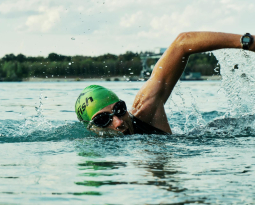
Work On Your Weakness – Blah, Blah, Blah
Happy New Year, everyone! I hope you’ve had a safe and enjoyable holiday season! Winter is here in the Midwest. Windchill, this morning in Omaha, was 20 below zero. Ugggghhh. So, you know what tri coaches say this time of year, right? Work on your weakness!
It sounds so boring. Whatever your “weakness” is, well, it’s a weakness, most likely because you don’t like working on it. Understood. But, there’s some truth in the statement that we should pay attention to it, like it or not. Now, if you LOVE swimming and thoroughly enjoy every lap you swim, stop reading. This blog post is not for you. If you were a competitive swimmer for years, find something else to do. This is for those who struggle with swimming or just don’t care for it much. It’s for those who are most happy when that cool-down is over, the workout is finished and you can now get to the stuff you enjoy much more.
The vast majority of triathletes I’ve talked to over the last 28 years admitted that their weakness is the swim. It was mine, so I get it. As I’ve shared before, the swim in my first tri involved my head being completely out of the water, side-stroking 1,000 yds. I didn’t wear goggles. No need to. My face wasn’t going in that murky darkness. I came to the sport as a runner with a 17:15 5K and a 35:25 10K. Good, but not great. Biking came pretty easily and became my best of the three disciplines after a few years.
But the swim? Man, I’ve been working on that for almost three decades. To be honest, I’ve enjoyed that swim training about, let’s see…once. Can’t remember that day, but I’m sure it’s out there somewhere in my past. My favorite part of any tri is exiting the water.
I have no competitive swim background AT ALL. There’s a great chance you’re just like me, and as much as you don’t want to read this, I don’t want to write it. Why? You might feel guilty about not swimming more or better or longer or with more concentration on form.
But hey, we’ve got to think about this because it IS part of the race. So, let’s make this short and sweet. Here are a few things to think about.
- Swim only as much as you need to in order to reach your goal(s). You may already be doing that, but if you minimize it because you don’t like it, it’s easier to make yourself get in. If you’re training for longer races, you WILL need to spend a good amount of time in the H2O, but only what you need. Having won three national championships, folks’ kind of freak out when I tell them I only swim two to three times a week, most of the time for 30 minutes, by myself. Yeah, that’s how much I don’t like it.
But, every lap and minute of those workouts are purposeful. Planned. Pointed towards the goal at hand. Yes, if I’m training for a 70.3 let’s say, I do get up to 45 min. workouts, but beyond that, I’d vomit in the pool and nobody wants that. Vomit not from the strain of the workout, but because I hate it.I do race-specific swim training. Lots of time trials matching my upcoming race distance. I’ll swim a certain duration for distance or, switch it around and swim a certain distance for time. For 70.3s, I’ll go 35 minutes straight for maximum distance after a ten-minute warm up. Or, maybe do the 2,000m for the best time I can muster. Doing that once every week or two is not a bad way to prepare for that distance. - Concentrate. If your swim time is minimal (compared to yardage freaks) then really concentrating on form and technique are paramount. I use a number of mental pictures and mantras when I swim to keep my form on point. Here are the four words I rehearse the most while flailing around.
a. “Tilt.” My head. I tilt it downward and look backward when exhaling to ensure my head is down so that my legs don’t drop. When turning to take a breath, I tilt the top of my head downward, using the “one-eyed breathing” technique with one goggle always underwater.
b. “Toes.” I want my big toes to tap each other, keeping my kick very small. They don’t touch every time they pass, but regularly. I also try to have the top of one foot “slap” the water every few kicks, again trying to keep my legs/feet up just under the surface.
c.”Wide.” I have a tendency to have my hands cross over that invisible center line that divides the right half of me from the left half. I want my hand to enter the water straight in front of my shoulder and for that to happen, it needs to feel like I have a wide hand entry. A video of your swim will show you what you need to see. If my stroke feels “wide,” then it’s probably right where it should be.
d. “Early.” Once my hand enters the water…and remember, hand lower than wrist, wrist lower than forearm, all tilting downward…I want to get to a vertical forearm ASAP. Get those fingers pointing downward with a straight forearm as quickly as you can. EVF. Early Vertical Forearm. It’ll help you to not drop your arm/elbow which negates much of the power in your pull.
So, “tilt, toes, wide, early.” I try to think about one of those for each lap, concentrating big-time on my technique. It’s very easy to just get sloppy with your technique, but if you’re doing minimal swimming, then every stroke counts. You know the adage: “Practice doesn’t make perfect. Perfect practice makes perfect.” - Fast swims come from three things. Good body position, good stroke technique and swim fitness. Best drill ever for good body position is the “kick-on-side” drill. YouTube this. Do it. Make it a part of every workout’s warm up. Learn to do it with your lower arm extended and then advance to both arms at your sides. Practice it until you own it. If you become a pro at this drill, your body position will be spot-on.
I tell triathletes to attempt to become good at all three events. That might mean taking some time away from your strength to work on your weakness. But it’ll be worth it. Typically, it’s the swim. Get a lesson. Have someone video you and evaluate. (I’d be glad to do that.) Joining a Master’s class can be huge. Make an appointment to swim with a friend. Do swim specific dry-land strength/resistance work.
Yes, work on your weakness as much as you can stand. After that, go do what you love to do. This is an honest article. No sense pretending that I love to swim. I have worked at it for many years and, for my age group, the “really old dudes”, I can hold my own. I’m thankful for that. This upcoming week, let’s see…yep, I’ll do two or three 30-minute swims. After all, it’s only January, right? If you hate or dislike swimming, don’t feel guilty. Join the club.










